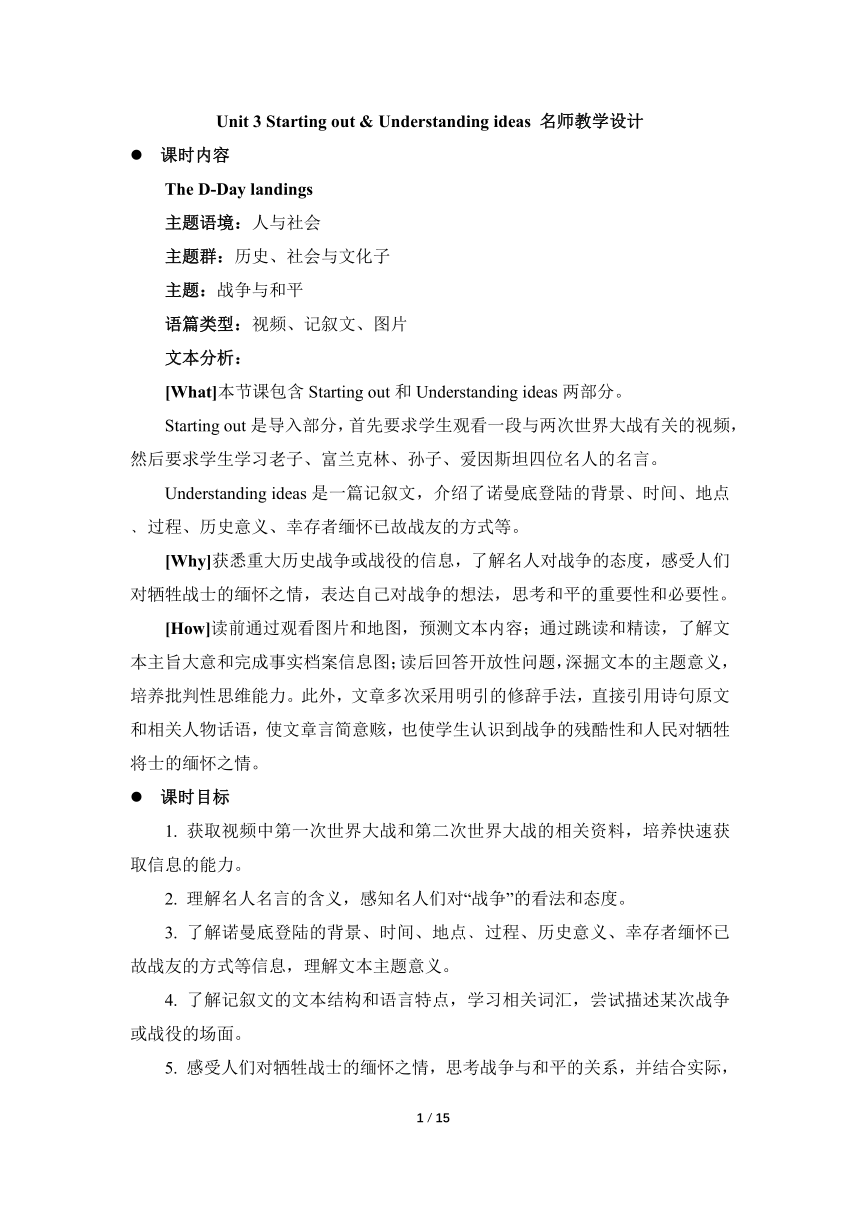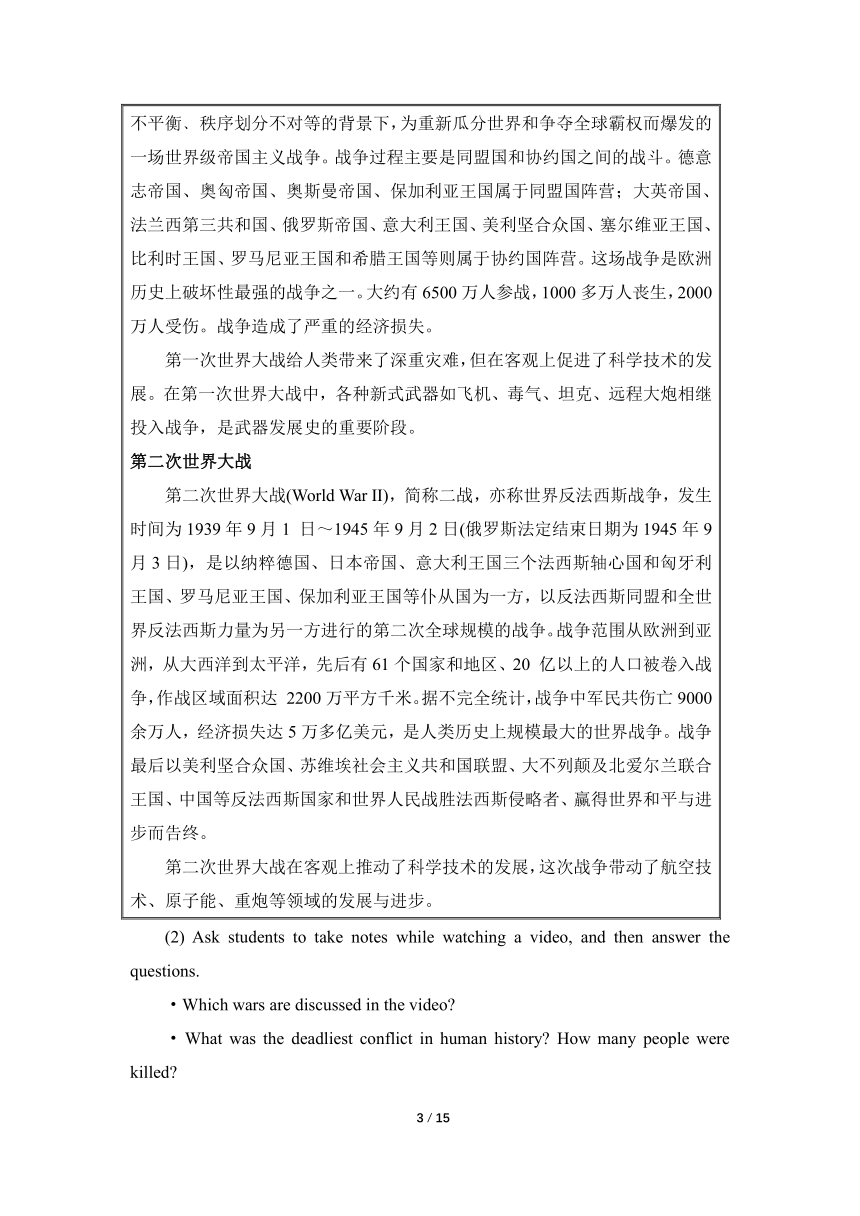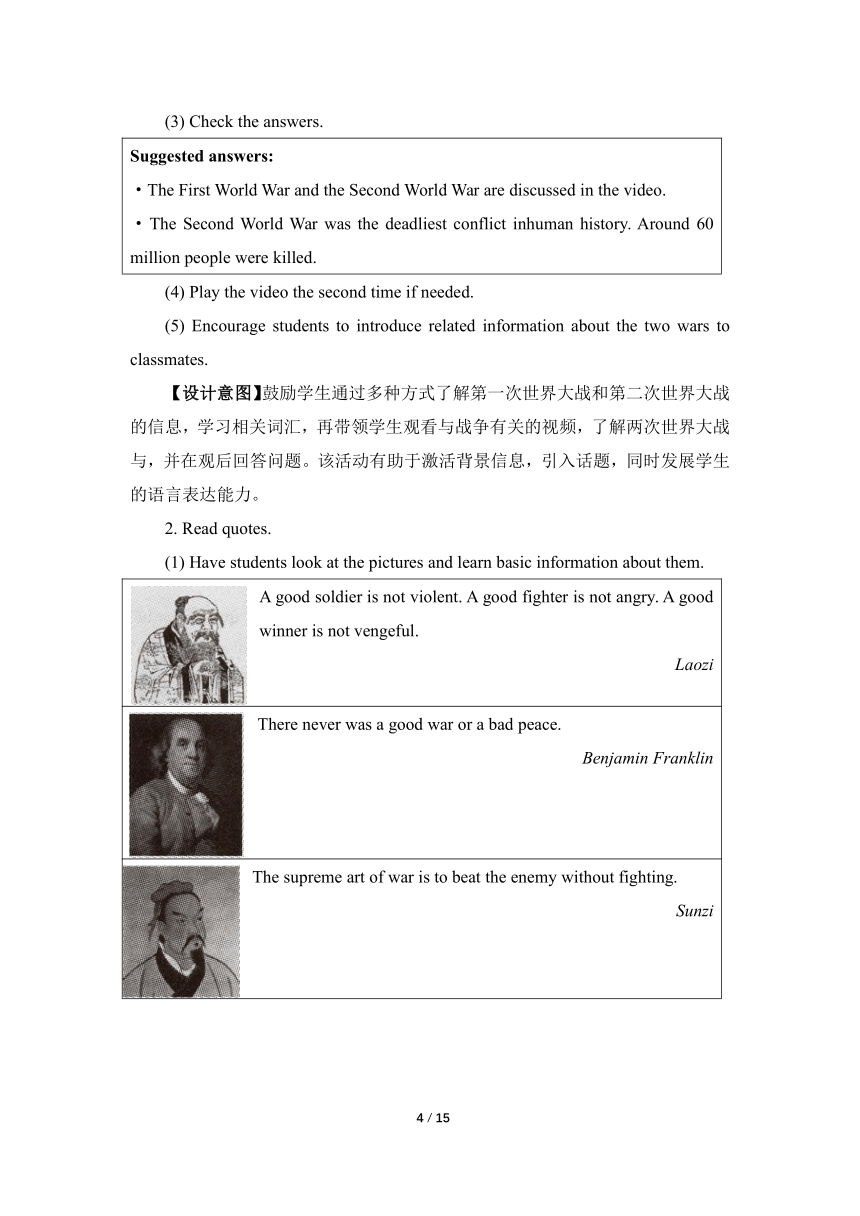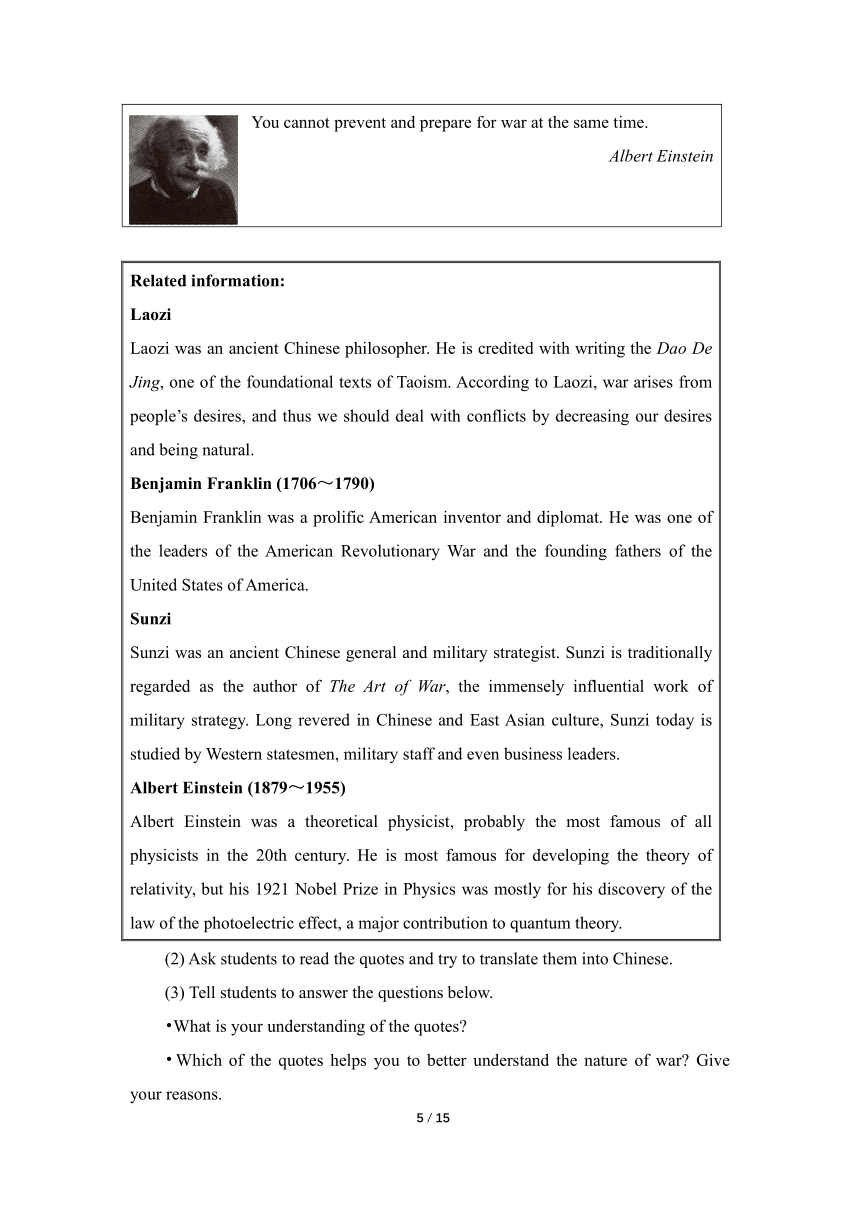外研版(2019)选择性必修 第三册Unit 3 War and peace Starting out and Understanding ideas名师教学设计
文档属性
| 名称 | 外研版(2019)选择性必修 第三册Unit 3 War and peace Starting out and Understanding ideas名师教学设计 |  | |
| 格式 | docx | ||
| 文件大小 | 3.1MB | ||
| 资源类型 | 教案 | ||
| 版本资源 | 外研版(2019) | ||
| 科目 | 英语 | ||
| 更新时间 | 2023-03-05 13:59:08 | ||
图片预览





文档简介
Unit 3 Starting out & Understanding ideas 名师教学设计
课时内容
The D-Day landings
主题语境:人与社会
主题群:历史、社会与文化子
主题:战争与和平
语篇类型:视频、记叙文、图片
文本分析:
[What]本节课包含Starting out和Understanding ideas两部分。
Starting out是导入部分,首先要求学生观看一段与两次世界大战有关的视频,然后要求学生学习老子、富兰克林、孙子、爱因斯坦四位名人的名言。
Understanding ideas是一篇记叙文,介绍了诺曼底登陆的背景、时间、地点﹑过程、历史意义、幸存者缅怀已故战友的方式等。
[Why]获悉重大历史战争或战役的信息,了解名人对战争的态度,感受人们对牺牲战士的缅怀之情,表达自己对战争的想法,思考和平的重要性和必要性。
[How]读前通过观看图片和地图,预测文本内容;通过跳读和精读,了解文本主旨大意和完成事实档案信息图;读后回答开放性问题,深掘文本的主题意义,培养批判性思维能力。此外,文章多次采用明引的修辞手法,直接引用诗句原文和相关人物话语,使文章言简意赅,也使学生认识到战争的残酷性和人民对牺牲将士的缅怀之情。
课时目标
1. 获取视频中第一次世界大战和第二次世界大战的相关资料,培养快速获取信息的能力。
2. 理解名人名言的含义,感知名人们对“战争”的看法和态度。
3. 了解诺曼底登陆的背景、时间、地点﹑过程、历史意义、幸存者缅怀已故战友的方式等信息,理解文本主题意义。
4. 了解记叙文的文本结构和语言特点,学习相关词汇,尝试描述某次战争或战役的场面。
5. 感受人们对牺牲战士的缅怀之情,思考战争与和平的关系,并结合实际,深思和平的重要性和维护和平的必要性。
重点难点
重点:
1. 了解诺曼底登陆的背景、时间、地点﹑过程、历史意义、幸存者缅怀已故战友的方式等信息,并能用自己的语言重述事件的大致经过。
2. 掌握记叙文的写法。
难点:
思考战争与和平的关系,深思战争的残酷性、和平的重要性和维护和平的必要性。
教学准备
教师准备:
1. 视频及播放设备。
2. 第一次世界大战﹑第二次世界大战、诺曼底登陆、四位名人生平等相关信息。
学生准备:
1. 预习本课词汇。
2. 了解某场具有历史意义的战争或战斗。
教学过程
Step I学习理解
活动一:感知与注意
1. Watch a video.
(1) Ask students to search for information about the First World War and the Second World War.
Related information: 第一次世界大战 第一次世界大战(World War I,1914年7月28日~1918年11月11日),简称“一战”,是在20世纪初资本主义国家向其终极阶段,即帝国主义过渡时产生的广泛的不可调和矛盾;亚洲、非洲、拉丁美洲、大洋洲的殖民地和半殖民地基本上被列强瓜分完毕;在新旧殖民主义矛盾激化,各帝国主义经济发展不平衡﹑秩序划分不对等的背景下,为重新瓜分世界和争夺全球霸权而爆发的一场世界级帝国主义战争。战争过程主要是同盟国和协约国之间的战斗。德意志帝国、奥匈帝国、奥斯曼帝国、保加利亚王国属于同盟国阵营;大英帝国、法兰西第三共和国、俄罗斯帝国、意大利王国、美利坚合众国、塞尔维亚王国、比利时王国、罗马尼亚王国和希腊王国等则属于协约国阵营。这场战争是欧洲历史上破坏性最强的战争之一。大约有6500万人参战,1000多万人丧生,2000万人受伤。战争造成了严重的经济损失。 第一次世界大战给人类带来了深重灾难,但在客观上促进了科学技术的发展。在第一次世界大战中,各种新式武器如飞机、毒气、坦克、远程大炮相继投入战争,是武器发展史的重要阶段。 第二次世界大战 第二次世界大战(World War II),简称二战,亦称世界反法西斯战争,发生时间为1939年9月1 日~1945年9月2日(俄罗斯法定结束日期为1945年9月3日),是以纳粹德国、日本帝国、意大利王国三个法西斯轴心国和匈牙利王国、罗马尼亚王国、保加利亚王国等仆从国为一方,以反法西斯同盟和全世界反法西斯力量为另一方进行的第二次全球规模的战争。战争范围从欧洲到亚洲,从大西洋到太平洋,先后有61个国家和地区、20 亿以上的人口被卷入战争,作战区域面积达 2200万平方千米。据不完全统计,战争中军民共伤亡9000余万人,经济损失达5万多亿美元,是人类历史上规模最大的世界战争。战争最后以美利坚合众国、苏维埃社会主义共和国联盟、大不列颠及北爱尔兰联合王国、中国等反法西斯国家和世界人民战胜法西斯侵略者、赢得世界和平与进步而告终。 第二次世界大战在客观上推动了科学技术的发展,这次战争带动了航空技术、原子能、重炮等领域的发展与进步。
(2) Ask students to take notes while watching a video, and then answer the questions.
·Which wars are discussed in the video
·What was the deadliest conflict in human history How many people were killed
(3) Check the answers.
Suggested answers: ·The First World War and the Second World War are discussed in the video. ·The Second World War was the deadliest conflict inhuman history. Around 60 million people were killed.
(4) Play the video the second time if needed.
(5) Encourage students to introduce related information about the two wars to classmates.
【设计意图】鼓励学生通过多种方式了解第一次世界大战和第二次世界大战的信息,学习相关词汇,再带领学生观看与战争有关的视频,了解两次世界大战与,并在观后回答问题。该活动有助于激活背景信息,引入话题,同时发展学生的语言表达能力。
2. Read quotes.
(1) Have students look at the pictures and learn basic information about them.
A good soldier is not violent. A good fighter is not angry. A good winner is not vengeful. Laozi
There never was a good war or a bad peace. Benjamin Franklin
The supreme art of war is to beat the enemy without fighting. Sunzi
You cannot prevent and prepare for war at the same time. Albert Einstein
Related information: Laozi Laozi was an ancient Chinese philosopher. He is credited with writing the Dao De Jing, one of the foundational texts of Taoism. According to Laozi, war arises from people’s desires, and thus we should deal with conflicts by decreasing our desires and being natural. Benjamin Franklin (1706~1790) Benjamin Franklin was a prolific American inventor and diplomat. He was one of the leaders of the American Revolutionary War and the founding fathers of the United States of America. Sunzi Sunzi was an ancient Chinese general and military strategist. Sunzi is traditionally regarded as the author of The Art of War, the immensely influential work of military strategy. Long revered in Chinese and East Asian culture, Sunzi today is studied by Western statesmen, military staff and even business leaders. Albert Einstein (1879~1955) Albert Einstein was a theoretical physicist, probably the most famous of all physicists in the 20th century. He is most famous for developing the theory of relativity, but his 1921 Nobel Prize in Physics was mostly for his discovery of the law of the photoelectric effect, a major contribution to quantum theory.
(2) Ask students to read the quotes and try to translate them into Chinese.
(3) Tell students to answer the questions below.
What is your understanding of the quotes
Which of the quotes helps you to better understand the nature of war Give your reasons.
What is your opinion on war Come up with three words or expressions to help express your opinion.
(4) Have students share answers in groups and in class.
(5) Check the answers as a class.
Suggested answers: (略)
【设计意图】引导学生观看四位名人的图片和阅读名言,并提醒学生感受说话人的情感,了解伟人们对于战争与和平的态度,注意其中的形容词和频度副词,为之后的活动做铺垫。
3. Look and answer.
(1) Ask students to look at a picture and a map, and then make some predictions.
(2) Tell students to answer the questions below and share in class. Then teacher evaluates students’ answers.
What do you think the picture and the map show
What do you expect to read about in the passage Share your ideas with the class.
Suggested answers: (略)
【设计意图】通过观看图片和地图,了解诺曼底登陆的相关背景知识,并根据图片内容预测课文,培养自主预习的能力和习惯,为下一步学习奠定基础。
活动二:获取与梳理
1. Imagine.
(1) Encourage students to look at the pictures below carefully and ask them what they can think of at the first sight.
(2) Learn the basic information about The Normandy landings.
Related information: The Normandy landings were a seaborne invasion of northern France that took place on Tuesday, 6 June1944 by American,British and Canadian forces. The largest seaborne invasion in history was code-named “Operation Overlord”, but it is more often referred to as “D-Day”. It enabled the liberation of France from German occupation, laying the foundations for the defeat of the German armies on the Western Front.
2. Read.
Ask students to read the passage and check their predictions.
3. Reread.
(1) Have students reread the passage and draw a fact file of this passage.
(2) Let students compare the fact file below with theirs and organise information from the passage to complete it.
The D-Day landings Date: ________________________ Place: ________________________ Aim of the operation: ___________________________________________ Supreme Allied Commander: _____________________________________ Timeline of the operation: Spring 1944 Allied troops _____________________________________ 6 June 1944 Start of __________________________________________ ·dawn: thousands of troops were journeying across __________________ mid-morning: hundreds of soldiers _______________________________ August 1944 The Allies liberated Paris and the Germans ____________ Outcome of the operation: _______________________________________
Suggested answers: Date: 6 June 1944 Place: the Normandy beaches Aim of the operation: to reach the Normandy beaches along about 80 kilometres of French coastline Supreme Allied Commander: General Eisenhower Timeline of the operation: Spring 1944gathered in large numbers. 6 June 1944 the Normandy landings (Operation Overlord) ·the English Channel to Normandy ·lay dead in the water and amongst the tanks on the beach August 1944 were removed from north-west France. Outcome of the operation: despite the high cost inhuman life, the D-Day landings were a success and were seen widely as the beginning of the end of the Second World War
【设计意图】首先鼓励学生展开想象,根据图片推测课文内容;然后阅读文本并核实推测;最后绘制文章结构图,并与本课结构图进行对比,引导学生梳理课文结构和主要信息,完成事实档案信息残缺部分,鼓励学生从语篇中获得新知,探究作者描写战争残酷的写作手法,建立信息间的关联,形成新的认知结构,进一步解读文本,扩展学生批判性思维。
活动三:概括与整合
1. Pair work.
(1) Ask students to work in pairs and introduce the D-Day landings to the partner in turns.
(2) Encourage students to give their presentations in class.
2. Write a summary.
Divide the whole class into several groups, and ask each group to write a summary about the D-Day landings. Share it in the class.
【设计意图】两人合作,复述事件;小组合作,撰写摘要,加深对文本的整合和对细节的掌握。
Step II应用实践
活动四:描述与阐释
Share feelings of reading.
Ask students to share the feelings of reading by answering the following question.
·Have you found anything you feel sad or pitiful after reading
【设计意图】以分享阅读感受为任务,鼓励学生独立思考,使学生深思战争的残酷以及战争给人类带来的影响。
活动五:分析与判断
1. Ask students to repeat the words and expressions related with wars they learnt in the passage.
2. Ask students to match the main ideas to the paragraphs and give their reasons.
□The outcome of the operation
□The background information of the operation
□The severe casualties on Omaha Beach
□The everlasting memory of the soldiers’ brave actions
□The initial stage of the operation
□The order issued by the Supreme Allied Commander before the operation
□The 70th anniversary of the D-Day landings
Suggested answers: 5,1,4,7,3,2,6
3. Ask students to discuss how the author describes the operation and presents historical facts to a powerful effect.
【设计意图】在学习理解类活动的基础上,要求学生学习与战争有关的词汇和表达,匹配各段大意及讨论描写战争场面的写作方法,促进了语言运用的自动化,助力学生将知识转化为能力。
Step Ⅲ 迁移创新
活动六:推理与论证
Group work.
Discuss why the author writes this passage.
【设计意图】引导学生探讨作者的写作目的,加深对主题意义的理解,思考战争的残酷性及和平的重要性。
活动七:批判与评价
1. 探讨文体特征。
记叙文,要把人物、事件或景物表述清楚,就必须具备记叙文不可缺少的基本要素,要回答六个“何”:何时,何地、何人、何事、为何、如何,即:when、where、who, what, why 和how。记叙文通常可分为三个部分,即开头、正文和结尾。 (1)开头 开头一般是对必要的背景要素做一个明确交代,主要叙述故事发生的时间、地点、人物,也可交代全文的主题。 (2)正文 文章的正文是叙述主体,是展开部分。在正文中,应以文章的开头为线索,详细地叙述说明文章的主题,告诉读者发生了什么事、如何发生的以及发生的原因,逐步展开情节,最后达到文章的高潮。 一篇好的记叙文应有冲突,有冲突才能达到高潮,文章才能有深度,才有力度。一般来说,有三种类型的冲突:不同人物之间的冲突;人与环境(自然环境和社会环境)之间的冲突;个人内心深处不同思想的冲突。 (3)结尾 记叙文的结尾要尽量自然,既要避免结尾软弱无力,也要避免画蛇添足,使读者迷惑不解。 ①首尾呼应,画龙点睛 ②自然结尾 随着文章的结束,文章自然而然地结尾。 ③含蓄性的结尾 用比喻或含蓄的手法不直接点明作者的看法,而是让读者自己去领会和思考。 ④指明方向,激励读者
2. 了解插图与主题意义的关联。
插图一 插图二
【作用】插图一由战斗机和红色标题构成,与文章第三段第三句“Meanwhile, thousands more were journeying across the English Channel to Normandy, protected by fighter planes in the skies above them.”呼应,红色醒目标题暗示着战争的残酷和血腥。插图二,沙滩上掉落的头盔,说明了战争的激烈和战士们的英勇。图片拉近了学生与文本的距离,培养了学生的观察和想象等能力。
3. 赏析语篇中的“引用”,探讨其与主题意义的关联。
(1) Learn.
引用是指在说话或写作中引用现成的话,如:诗句、格言﹑成语等,以表达自己思想感情的修辞方法。引用可分为明引和暗引两种。明引指直接引用原文,并加上引号,或者是只引用原文大意,不加引号,但是都注明原文的出处。暗引指不说明引文出处,而将其编织在自己的话语中,或是引用原句,或是只引大意。运用引用,既可使文章言简意赅,有助于说理抒情;又可增加文采,增强表现力。
(2) Apply.
How are these methods applied in the passage
Suggested answers: ①An order issued by Supreme Allied Commander General Eisenhower to the troops read: “Your task will not be an easy one. Your enemy is well trained, well equipped and battle-hardened... But this is the year 1944...The tide has turned! The free men of the world are marching together to Victory! I have full confidence in your courage,devotion to duty and skill in battle. We will accept nothing less than full Victory!” 引用盟军最高司令艾森豪威尔将军鼓舞军队士气的一段话展示了人们反法西斯的决心和信心。 ②I was the first one out. The seventh man was the next one to get across the beach without being hit. All the ones in between were hit. Two were killed; three were injured. That’s how lucky you had to be. 引用在轰炸中侥幸脱险的士兵的回忆,将战争的激烈直观地呈现在读者面前。 ③They shall grow not old, as we that are left grow old: Age shall not weary them, nor the years condemn. At the going down of the sun and in the morning we will remember them. 引用英国诗人Laurence Binyon在《谨献给阵亡将士》诗中的一段,表达了对阵亡将士的缅怀之情。
【设计意图】引导学生探讨记叙文的文体特征,分析插图及引用在文中的作用,使学生加深对课文内容的理解和熟悉作者的写作手法。
活动八:想象与创造
1. Think and share.
Have students discuss the following questions.
What is the historical significance of the D-Day landings
What is your understanding of the poem For the Fallen
How can you use the language you have learnt to describe another event during the Second World War Share your ideas with the class.
Suggested answers: ·The D-Day landings were the largest combined sea, air and land operation in history. The operation was seen widely as the beginning of the end of the Second World War. ·(略) ·(略)
【设计意图】通过讨论,进一步理解文章的主题。鼓励学生在深入理解课文的同时回顾历史,描述另一场战争,进行知识和思维能力的拓展和迁移,培养高阶思维。
2. Watch.
Ask students to watch the following videos and share their feelings.
《断刀》
《刀锋》
《跨过鸭绿江》
Related information: 纪录片《断刀》讲述抗美援朝战争第二次战役的西线故事;《刀锋》讲述的是抗美援朝的东线故事——长津湖战役;电视剧《跨过鸭绿江》全景式展现了抗美援朝战争和抗美援朝运动。
【设计意图】通过观看纪录片和电视剧,了解抗美援朝战争的相关信息(这是新中国被迫进行的一场反侵略战争。70多年前,当跨过鸭绿江的志愿军走出国门后,他们凭借远落后于对手的武器装备,却打出了国威,打出了军威,打出了中国人大写的尊严。此战,不仅达到了“抗美援朝、保家卫国”的战略目的,而且对中国,对朝鲜,对东方,乃至对于整个世界都深具意义。),感受人们对曾经鏖战在清川江、长津湖、上甘岭的志愿军前辈以及所有奋战在抗美援朝战争中的志愿军战士的缅怀之情,启发学生思考维护和平的重要性。
3. Design an interview.
Imagine you are a reporter, and you will interview some survivors of the D-Day landings,please make a dialogue for this interview.
【设计意图】设计采访环节,要求学生设计一段对话,以幸存者的视角重现历史事件,引导学生比较“战争与和平”给人们带来的不同影响,培养学生的批判性思维。
板书设计
Unit 3 War and peace Period I Starting out & Understanding ideas Ⅰ. 学习理解 活动一:感知与注意 1. Watch a video. 2. Read quotes. 3. Look and answer. 活动二:获取与梳理 1. Imagine. 2. Read. 3. Reread. 活动三:概括与整合 1. Pair work. 2. Write a summary. Ⅱ. 应用实践 活动四:描述与阐释 Share feelings of reading. 活动五:分析与判断 Ⅲ. 迁移创新 活动六:推理与论证 Group work. 活动七:批判与评价 1. 探讨文体特征。 2. 了解插图与主题意义的关联。 3. 赏析“引用”的作用。 (1) Learn. (2) Apply. 活动八:想象与创造 1. Think and share. 2. Watch. 3. Design an interview.
2 / 2
课时内容
The D-Day landings
主题语境:人与社会
主题群:历史、社会与文化子
主题:战争与和平
语篇类型:视频、记叙文、图片
文本分析:
[What]本节课包含Starting out和Understanding ideas两部分。
Starting out是导入部分,首先要求学生观看一段与两次世界大战有关的视频,然后要求学生学习老子、富兰克林、孙子、爱因斯坦四位名人的名言。
Understanding ideas是一篇记叙文,介绍了诺曼底登陆的背景、时间、地点﹑过程、历史意义、幸存者缅怀已故战友的方式等。
[Why]获悉重大历史战争或战役的信息,了解名人对战争的态度,感受人们对牺牲战士的缅怀之情,表达自己对战争的想法,思考和平的重要性和必要性。
[How]读前通过观看图片和地图,预测文本内容;通过跳读和精读,了解文本主旨大意和完成事实档案信息图;读后回答开放性问题,深掘文本的主题意义,培养批判性思维能力。此外,文章多次采用明引的修辞手法,直接引用诗句原文和相关人物话语,使文章言简意赅,也使学生认识到战争的残酷性和人民对牺牲将士的缅怀之情。
课时目标
1. 获取视频中第一次世界大战和第二次世界大战的相关资料,培养快速获取信息的能力。
2. 理解名人名言的含义,感知名人们对“战争”的看法和态度。
3. 了解诺曼底登陆的背景、时间、地点﹑过程、历史意义、幸存者缅怀已故战友的方式等信息,理解文本主题意义。
4. 了解记叙文的文本结构和语言特点,学习相关词汇,尝试描述某次战争或战役的场面。
5. 感受人们对牺牲战士的缅怀之情,思考战争与和平的关系,并结合实际,深思和平的重要性和维护和平的必要性。
重点难点
重点:
1. 了解诺曼底登陆的背景、时间、地点﹑过程、历史意义、幸存者缅怀已故战友的方式等信息,并能用自己的语言重述事件的大致经过。
2. 掌握记叙文的写法。
难点:
思考战争与和平的关系,深思战争的残酷性、和平的重要性和维护和平的必要性。
教学准备
教师准备:
1. 视频及播放设备。
2. 第一次世界大战﹑第二次世界大战、诺曼底登陆、四位名人生平等相关信息。
学生准备:
1. 预习本课词汇。
2. 了解某场具有历史意义的战争或战斗。
教学过程
Step I学习理解
活动一:感知与注意
1. Watch a video.
(1) Ask students to search for information about the First World War and the Second World War.
Related information: 第一次世界大战 第一次世界大战(World War I,1914年7月28日~1918年11月11日),简称“一战”,是在20世纪初资本主义国家向其终极阶段,即帝国主义过渡时产生的广泛的不可调和矛盾;亚洲、非洲、拉丁美洲、大洋洲的殖民地和半殖民地基本上被列强瓜分完毕;在新旧殖民主义矛盾激化,各帝国主义经济发展不平衡﹑秩序划分不对等的背景下,为重新瓜分世界和争夺全球霸权而爆发的一场世界级帝国主义战争。战争过程主要是同盟国和协约国之间的战斗。德意志帝国、奥匈帝国、奥斯曼帝国、保加利亚王国属于同盟国阵营;大英帝国、法兰西第三共和国、俄罗斯帝国、意大利王国、美利坚合众国、塞尔维亚王国、比利时王国、罗马尼亚王国和希腊王国等则属于协约国阵营。这场战争是欧洲历史上破坏性最强的战争之一。大约有6500万人参战,1000多万人丧生,2000万人受伤。战争造成了严重的经济损失。 第一次世界大战给人类带来了深重灾难,但在客观上促进了科学技术的发展。在第一次世界大战中,各种新式武器如飞机、毒气、坦克、远程大炮相继投入战争,是武器发展史的重要阶段。 第二次世界大战 第二次世界大战(World War II),简称二战,亦称世界反法西斯战争,发生时间为1939年9月1 日~1945年9月2日(俄罗斯法定结束日期为1945年9月3日),是以纳粹德国、日本帝国、意大利王国三个法西斯轴心国和匈牙利王国、罗马尼亚王国、保加利亚王国等仆从国为一方,以反法西斯同盟和全世界反法西斯力量为另一方进行的第二次全球规模的战争。战争范围从欧洲到亚洲,从大西洋到太平洋,先后有61个国家和地区、20 亿以上的人口被卷入战争,作战区域面积达 2200万平方千米。据不完全统计,战争中军民共伤亡9000余万人,经济损失达5万多亿美元,是人类历史上规模最大的世界战争。战争最后以美利坚合众国、苏维埃社会主义共和国联盟、大不列颠及北爱尔兰联合王国、中国等反法西斯国家和世界人民战胜法西斯侵略者、赢得世界和平与进步而告终。 第二次世界大战在客观上推动了科学技术的发展,这次战争带动了航空技术、原子能、重炮等领域的发展与进步。
(2) Ask students to take notes while watching a video, and then answer the questions.
·Which wars are discussed in the video
·What was the deadliest conflict in human history How many people were killed
(3) Check the answers.
Suggested answers: ·The First World War and the Second World War are discussed in the video. ·The Second World War was the deadliest conflict inhuman history. Around 60 million people were killed.
(4) Play the video the second time if needed.
(5) Encourage students to introduce related information about the two wars to classmates.
【设计意图】鼓励学生通过多种方式了解第一次世界大战和第二次世界大战的信息,学习相关词汇,再带领学生观看与战争有关的视频,了解两次世界大战与,并在观后回答问题。该活动有助于激活背景信息,引入话题,同时发展学生的语言表达能力。
2. Read quotes.
(1) Have students look at the pictures and learn basic information about them.
A good soldier is not violent. A good fighter is not angry. A good winner is not vengeful. Laozi
There never was a good war or a bad peace. Benjamin Franklin
The supreme art of war is to beat the enemy without fighting. Sunzi
You cannot prevent and prepare for war at the same time. Albert Einstein
Related information: Laozi Laozi was an ancient Chinese philosopher. He is credited with writing the Dao De Jing, one of the foundational texts of Taoism. According to Laozi, war arises from people’s desires, and thus we should deal with conflicts by decreasing our desires and being natural. Benjamin Franklin (1706~1790) Benjamin Franklin was a prolific American inventor and diplomat. He was one of the leaders of the American Revolutionary War and the founding fathers of the United States of America. Sunzi Sunzi was an ancient Chinese general and military strategist. Sunzi is traditionally regarded as the author of The Art of War, the immensely influential work of military strategy. Long revered in Chinese and East Asian culture, Sunzi today is studied by Western statesmen, military staff and even business leaders. Albert Einstein (1879~1955) Albert Einstein was a theoretical physicist, probably the most famous of all physicists in the 20th century. He is most famous for developing the theory of relativity, but his 1921 Nobel Prize in Physics was mostly for his discovery of the law of the photoelectric effect, a major contribution to quantum theory.
(2) Ask students to read the quotes and try to translate them into Chinese.
(3) Tell students to answer the questions below.
What is your understanding of the quotes
Which of the quotes helps you to better understand the nature of war Give your reasons.
What is your opinion on war Come up with three words or expressions to help express your opinion.
(4) Have students share answers in groups and in class.
(5) Check the answers as a class.
Suggested answers: (略)
【设计意图】引导学生观看四位名人的图片和阅读名言,并提醒学生感受说话人的情感,了解伟人们对于战争与和平的态度,注意其中的形容词和频度副词,为之后的活动做铺垫。
3. Look and answer.
(1) Ask students to look at a picture and a map, and then make some predictions.
(2) Tell students to answer the questions below and share in class. Then teacher evaluates students’ answers.
What do you think the picture and the map show
What do you expect to read about in the passage Share your ideas with the class.
Suggested answers: (略)
【设计意图】通过观看图片和地图,了解诺曼底登陆的相关背景知识,并根据图片内容预测课文,培养自主预习的能力和习惯,为下一步学习奠定基础。
活动二:获取与梳理
1. Imagine.
(1) Encourage students to look at the pictures below carefully and ask them what they can think of at the first sight.
(2) Learn the basic information about The Normandy landings.
Related information: The Normandy landings were a seaborne invasion of northern France that took place on Tuesday, 6 June1944 by American,British and Canadian forces. The largest seaborne invasion in history was code-named “Operation Overlord”, but it is more often referred to as “D-Day”. It enabled the liberation of France from German occupation, laying the foundations for the defeat of the German armies on the Western Front.
2. Read.
Ask students to read the passage and check their predictions.
3. Reread.
(1) Have students reread the passage and draw a fact file of this passage.
(2) Let students compare the fact file below with theirs and organise information from the passage to complete it.
The D-Day landings Date: ________________________ Place: ________________________ Aim of the operation: ___________________________________________ Supreme Allied Commander: _____________________________________ Timeline of the operation: Spring 1944 Allied troops _____________________________________ 6 June 1944 Start of __________________________________________ ·dawn: thousands of troops were journeying across __________________ mid-morning: hundreds of soldiers _______________________________ August 1944 The Allies liberated Paris and the Germans ____________ Outcome of the operation: _______________________________________
Suggested answers: Date: 6 June 1944 Place: the Normandy beaches Aim of the operation: to reach the Normandy beaches along about 80 kilometres of French coastline Supreme Allied Commander: General Eisenhower Timeline of the operation: Spring 1944gathered in large numbers. 6 June 1944 the Normandy landings (Operation Overlord) ·the English Channel to Normandy ·lay dead in the water and amongst the tanks on the beach August 1944 were removed from north-west France. Outcome of the operation: despite the high cost inhuman life, the D-Day landings were a success and were seen widely as the beginning of the end of the Second World War
【设计意图】首先鼓励学生展开想象,根据图片推测课文内容;然后阅读文本并核实推测;最后绘制文章结构图,并与本课结构图进行对比,引导学生梳理课文结构和主要信息,完成事实档案信息残缺部分,鼓励学生从语篇中获得新知,探究作者描写战争残酷的写作手法,建立信息间的关联,形成新的认知结构,进一步解读文本,扩展学生批判性思维。
活动三:概括与整合
1. Pair work.
(1) Ask students to work in pairs and introduce the D-Day landings to the partner in turns.
(2) Encourage students to give their presentations in class.
2. Write a summary.
Divide the whole class into several groups, and ask each group to write a summary about the D-Day landings. Share it in the class.
【设计意图】两人合作,复述事件;小组合作,撰写摘要,加深对文本的整合和对细节的掌握。
Step II应用实践
活动四:描述与阐释
Share feelings of reading.
Ask students to share the feelings of reading by answering the following question.
·Have you found anything you feel sad or pitiful after reading
【设计意图】以分享阅读感受为任务,鼓励学生独立思考,使学生深思战争的残酷以及战争给人类带来的影响。
活动五:分析与判断
1. Ask students to repeat the words and expressions related with wars they learnt in the passage.
2. Ask students to match the main ideas to the paragraphs and give their reasons.
□The outcome of the operation
□The background information of the operation
□The severe casualties on Omaha Beach
□The everlasting memory of the soldiers’ brave actions
□The initial stage of the operation
□The order issued by the Supreme Allied Commander before the operation
□The 70th anniversary of the D-Day landings
Suggested answers: 5,1,4,7,3,2,6
3. Ask students to discuss how the author describes the operation and presents historical facts to a powerful effect.
【设计意图】在学习理解类活动的基础上,要求学生学习与战争有关的词汇和表达,匹配各段大意及讨论描写战争场面的写作方法,促进了语言运用的自动化,助力学生将知识转化为能力。
Step Ⅲ 迁移创新
活动六:推理与论证
Group work.
Discuss why the author writes this passage.
【设计意图】引导学生探讨作者的写作目的,加深对主题意义的理解,思考战争的残酷性及和平的重要性。
活动七:批判与评价
1. 探讨文体特征。
记叙文,要把人物、事件或景物表述清楚,就必须具备记叙文不可缺少的基本要素,要回答六个“何”:何时,何地、何人、何事、为何、如何,即:when、where、who, what, why 和how。记叙文通常可分为三个部分,即开头、正文和结尾。 (1)开头 开头一般是对必要的背景要素做一个明确交代,主要叙述故事发生的时间、地点、人物,也可交代全文的主题。 (2)正文 文章的正文是叙述主体,是展开部分。在正文中,应以文章的开头为线索,详细地叙述说明文章的主题,告诉读者发生了什么事、如何发生的以及发生的原因,逐步展开情节,最后达到文章的高潮。 一篇好的记叙文应有冲突,有冲突才能达到高潮,文章才能有深度,才有力度。一般来说,有三种类型的冲突:不同人物之间的冲突;人与环境(自然环境和社会环境)之间的冲突;个人内心深处不同思想的冲突。 (3)结尾 记叙文的结尾要尽量自然,既要避免结尾软弱无力,也要避免画蛇添足,使读者迷惑不解。 ①首尾呼应,画龙点睛 ②自然结尾 随着文章的结束,文章自然而然地结尾。 ③含蓄性的结尾 用比喻或含蓄的手法不直接点明作者的看法,而是让读者自己去领会和思考。 ④指明方向,激励读者
2. 了解插图与主题意义的关联。
插图一 插图二
【作用】插图一由战斗机和红色标题构成,与文章第三段第三句“Meanwhile, thousands more were journeying across the English Channel to Normandy, protected by fighter planes in the skies above them.”呼应,红色醒目标题暗示着战争的残酷和血腥。插图二,沙滩上掉落的头盔,说明了战争的激烈和战士们的英勇。图片拉近了学生与文本的距离,培养了学生的观察和想象等能力。
3. 赏析语篇中的“引用”,探讨其与主题意义的关联。
(1) Learn.
引用是指在说话或写作中引用现成的话,如:诗句、格言﹑成语等,以表达自己思想感情的修辞方法。引用可分为明引和暗引两种。明引指直接引用原文,并加上引号,或者是只引用原文大意,不加引号,但是都注明原文的出处。暗引指不说明引文出处,而将其编织在自己的话语中,或是引用原句,或是只引大意。运用引用,既可使文章言简意赅,有助于说理抒情;又可增加文采,增强表现力。
(2) Apply.
How are these methods applied in the passage
Suggested answers: ①An order issued by Supreme Allied Commander General Eisenhower to the troops read: “Your task will not be an easy one. Your enemy is well trained, well equipped and battle-hardened... But this is the year 1944...The tide has turned! The free men of the world are marching together to Victory! I have full confidence in your courage,devotion to duty and skill in battle. We will accept nothing less than full Victory!” 引用盟军最高司令艾森豪威尔将军鼓舞军队士气的一段话展示了人们反法西斯的决心和信心。 ②I was the first one out. The seventh man was the next one to get across the beach without being hit. All the ones in between were hit. Two were killed; three were injured. That’s how lucky you had to be. 引用在轰炸中侥幸脱险的士兵的回忆,将战争的激烈直观地呈现在读者面前。 ③They shall grow not old, as we that are left grow old: Age shall not weary them, nor the years condemn. At the going down of the sun and in the morning we will remember them. 引用英国诗人Laurence Binyon在《谨献给阵亡将士》诗中的一段,表达了对阵亡将士的缅怀之情。
【设计意图】引导学生探讨记叙文的文体特征,分析插图及引用在文中的作用,使学生加深对课文内容的理解和熟悉作者的写作手法。
活动八:想象与创造
1. Think and share.
Have students discuss the following questions.
What is the historical significance of the D-Day landings
What is your understanding of the poem For the Fallen
How can you use the language you have learnt to describe another event during the Second World War Share your ideas with the class.
Suggested answers: ·The D-Day landings were the largest combined sea, air and land operation in history. The operation was seen widely as the beginning of the end of the Second World War. ·(略) ·(略)
【设计意图】通过讨论,进一步理解文章的主题。鼓励学生在深入理解课文的同时回顾历史,描述另一场战争,进行知识和思维能力的拓展和迁移,培养高阶思维。
2. Watch.
Ask students to watch the following videos and share their feelings.
《断刀》
《刀锋》
《跨过鸭绿江》
Related information: 纪录片《断刀》讲述抗美援朝战争第二次战役的西线故事;《刀锋》讲述的是抗美援朝的东线故事——长津湖战役;电视剧《跨过鸭绿江》全景式展现了抗美援朝战争和抗美援朝运动。
【设计意图】通过观看纪录片和电视剧,了解抗美援朝战争的相关信息(这是新中国被迫进行的一场反侵略战争。70多年前,当跨过鸭绿江的志愿军走出国门后,他们凭借远落后于对手的武器装备,却打出了国威,打出了军威,打出了中国人大写的尊严。此战,不仅达到了“抗美援朝、保家卫国”的战略目的,而且对中国,对朝鲜,对东方,乃至对于整个世界都深具意义。),感受人们对曾经鏖战在清川江、长津湖、上甘岭的志愿军前辈以及所有奋战在抗美援朝战争中的志愿军战士的缅怀之情,启发学生思考维护和平的重要性。
3. Design an interview.
Imagine you are a reporter, and you will interview some survivors of the D-Day landings,please make a dialogue for this interview.
【设计意图】设计采访环节,要求学生设计一段对话,以幸存者的视角重现历史事件,引导学生比较“战争与和平”给人们带来的不同影响,培养学生的批判性思维。
板书设计
Unit 3 War and peace Period I Starting out & Understanding ideas Ⅰ. 学习理解 活动一:感知与注意 1. Watch a video. 2. Read quotes. 3. Look and answer. 活动二:获取与梳理 1. Imagine. 2. Read. 3. Reread. 活动三:概括与整合 1. Pair work. 2. Write a summary. Ⅱ. 应用实践 活动四:描述与阐释 Share feelings of reading. 活动五:分析与判断 Ⅲ. 迁移创新 活动六:推理与论证 Group work. 活动七:批判与评价 1. 探讨文体特征。 2. 了解插图与主题意义的关联。 3. 赏析“引用”的作用。 (1) Learn. (2) Apply. 活动八:想象与创造 1. Think and share. 2. Watch. 3. Design an interview.
2 / 2
